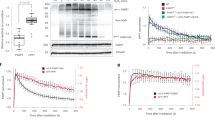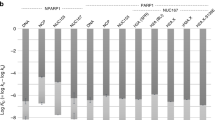Abstract
Poly-ADP-ribosylation is a post-translational modification catalyzed by PARP enzymes with roles in transcription and chromatin biology. Here we show that distinct macrodomains, including those of histone macroH2A1.1, are recruited to sites of PARP1 activation induced by laser-generated DNA damage. Chemical PARP1 inhibitors, PARP1 knockdown and mutation of ADP-ribose–binding residues in macroH2A1.1 abrogate macrodomain recruitment. Notably, histone macroH2A1.1 senses PARP1 activation, transiently compacts chromatin, reduces the recruitment of DNA damage factor Ku70–Ku80 and alters γ-H2AX patterns, whereas the splice variant macroH2A1.2, which is deficient in poly-ADP-ribose binding, does not mediate chromatin rearrangements upon PARP1 activation. The structure of the macroH2A1.1 macrodomain in complex with ADP-ribose establishes a poly-ADP-ribose cap-binding function and reveals conformational changes in the macrodomain upon ligand binding. We thus identify macrodomains as modules that directly sense PARP activation in vivo and establish macroH2A histones as dynamic regulators of chromatin plasticity.
This is a preview of subscription content, access via your institution
Access options
Subscribe to this journal
Receive 12 print issues and online access
$189.00 per year
only $15.75 per issue
Buy this article
- Purchase on Springer Link
- Instant access to full article PDF
Prices may be subject to local taxes which are calculated during checkout






Similar content being viewed by others
References
Woodcock, C.L. Chromatin architecture. Curr. Opin. Struct. Biol. 16, 213–220 (2006).
Hassa, P.O., Haenni, S.S., Elser, M. & Hottiger, M.O. Nuclear ADP-ribosylation reactions in mammalian cells: where are we today and where are we going? Microbiol. Mol. Biol. Rev. 70, 789–829 (2006).
Hassa, P.O. & Hottiger, M.O. The diverse biological roles of mammalian PARPS, a small but powerful family of poly-ADP-ribose polymerases. Front. Biosci. 13, 3046–3082 (2008).
D'Amours, D., Desnoyers, S., D'Silva, I. & Poirier, G.G. Poly(ADP-ribosyl)ation reactions in the regulation of nuclear functions. Biochem. J. 342, 249–268 (1999).
Kun, E., Kirsten, E., Mendeleyev, J. & Ordahl, C.P. Regulation of the enzymatic catalysis of poly(ADP-ribose) polymerase by dsDNA, polyamines, Mg2+, Ca2+, histones H1 and H3, and ATP. Biochemistry 43, 210–216 (2004).
Gagné, J.P. et al. Proteome-wide identification of poly(ADP-ribose) binding proteins and poly(ADP-ribose)-associated protein complexes. Nucleic Acids Res. 36, 6959–6976 (2008).
Ladurner, A.G. Inactivating chromosomes: a macro domain that minimizes transcription. Mol. Cell 12, 1–3 (2003).
Ouararhni, K. et al. The histone variant mH2A1.1 interferes with transcription by down-regulating PARP-1 enzymatic activity. Genes Dev. 20, 3324–3336 (2006).
Nusinow, D.A. et al. Poly(ADP-ribose) polymerase 1 is inhibited by a histone H2A variant, MacroH2A, and contributes to silencing of the inactive X chromosome. J. Biol. Chem. 282, 12851–12859 (2007).
Karras, G.I. et al. The macro domain is an ADP-ribose binding module. EMBO J. 24, 1911–1920 (2005).
Kirsten, E., Kun, E., Mendeleyev, J. & Ordahl, C.P. Activity assays for poly-ADP ribose polymerase. Methods Mol. Biol. 287, 137–149 (2004).
Fahrer, J., Kranaster, R., Altmeyer, M., Marx, A. & Bürkle, A. Quantitative analysis of the binding affinity of poly(ADP-ribose) to specific binding proteins as a function of chain length. Nucleic Acids Res. 35, e143 (2007).
Sporn, J. et al. MacroH2A1.1 predicts the risk of lung cancer recurrence. Oncogene advance online publication, doi: 10.1038/onc.2009.26 (3 August 2009).
Gottschalk, A.J. et al. Poly-(ADP-ribosyl)ation directs recruitment and activation of an ATP-dependent chromatin remodeler. Proc. Natl. Acad. Sci. USA advance online publication, doi: 10.1073/pnas.0906920106 (6 August 2009).
Heo, K. et al. FACT-mediated exchange of histone variant H2AX regulated by phosphorylation of H2AX and ADP-ribosylation of Spt16. Mol. Cell 30, 86–97 (2008).
Kustatscher, G., Hothorn, M., Pugieux, C., Scheffzek, K. & Ladurner, A.G. Splicing regulates NAD metabolite binding to histone macroH2A. Nat. Struct. Mol. Biol. 12, 624–625 (2005).
Hassa, P.O., Covic, M., Hasan, S., Imhof, R. & Hottiger, M.O. The enzymatic and DNA binding activity of PARP-1 are not required for NF-κB coactivator function. J. Biol. Chem. 276, 45588–45597 (2001).
Altmeyer, M., Messner, S., Hassa, P.O., Fey, M. & Hottiger, M.O. Molecular mechanism of poly(ADP-ribosyl)ation by PARP1 and identification of lysine residues as ADP-ribose acceptor sites. Nucleic Acids Res. 37, 3723–3738 (2009).
Kim, M.Y., Mauro, S., Gevry, N., Lis, J.T. & Kraus, W.L. NAD+-dependent modulation of chromatin structure and transcription by nucleosome binding properties of PARP-1. Cell 119, 803–814 (2004).
Krishnakumar, R. et al. Reciprocal binding of PARP-1 and histone H1 at promoters specifies transcriptional outcomes. Science 319, 819–821 (2008).
Rouleau, M., Aubin, R.A. & Poirier, G.G. Poly(ADP-ribosyl)ated chromatin domains: access granted. J. Cell Sci. 117, 815–825 (2004).
Ju, B.G. et al. A topoisomerase IIβ-mediated dsDNA break required for regulated transcription. Science 312, 1798–1802 (2006).
Pavri, R. et al. Histone H2B monoubiquitination functions cooperatively with FACT to regulate elongation by RNA polymerase II. Cell 125, 703–717 (2006).
Cohen-Armon, M. et al. DNA-independent PARP-1 activation by phosphorylated ERK2 increases Elk1 activity: a link to histone acetylation. Mol. Cell 25, 297–308 (2007).
Homburg, S. et al. A fast signal-induced activation of Poly(ADP-ribose) polymerase: a novel downstream target of phospholipase c. J. Cell Biol. 150, 293–307 (2000).
Haenni, S.S. et al. Identification of lysines 36 and 37 of PARP-2 as targets for acetylation and auto-ADP-ribosylation. Int. J. Biochem. Cell Biol. 40, 2274–2283 (2008).
Wong, R.H.F. et al. A role of DNA-PK for the metabolic gene regulation in response to insulin. Cell 136, 1056–1072 (2009).
Changolkar, L.N. et al. Developmental changes in histone macroH2A1-mediated gene regulation. Mol. Cell. Biol. 27, 2758–2764 (2007).
Pehrson, J.R., Costanzi, C. & Dharia, C. Developmental and tissue expression patterns of histone macroH2A1 subtypes. J. Cell. Biochem. 65, 107–113 (1997).
Costanzi, C. & Pehrson, J.R. MACROH2A2, a new member of the MACROH2A core histone family. J. Biol. Chem. 276, 21776–21784 (2001).
Hassa, P.O. et al. Acetylation of poly(ADP-ribose) polymerase-1 by p300/CREB-binding protein regulates coactivation of NF-κB-dependent transcription. J. Biol. Chem. 280, 40450–40464 (2005).
Pétrilli, V. et al. Noncleavable poly(ADP-ribose) polymerase-1 regulates the inflammation response in mice. J. Clin. Invest. 114, 1072–1081 (2004).
Nakatani, Y. & Ogryzko, V. Immunoaffinity purification of mammalian protein complexes. Methods Enzymol. 370, 430–444 (2003).
Colombelli, J., Grill, S.W. & Stelzer, E.H.K. Ultraviolet diffraction limited nanosurgery of live biological tissues. Rev. Sci. Instrum. 75, 472 (2004).
Thévenaz, P., Ruttimann, U.E. & Unser, M. A pyramid approach to subpixel registration based on intensity. IEEE Trans. Image Process. 7, 27–41 (1998).
Colombelli, J. et al. A correlative light and electron microscopy method based on laser micropatterning and etching. in Membrane Trafficking Vol. 457 (ed. Vancura, A.) 203–213 (Human Press, Clifton, NJ, 2008).
Kabsch, W. Automatic processing of rotation diffraction data from crystals of initially unknown symmetry and cell constants. J. Appl. Crystallogr. 26, 795–800 (1993).
McCoy, A.J., Grosse-Kunstleve, R.W., Storoni, L.C. & Read, R.J. Likelihood-enhanced fast translation functions. Acta Crystallogr. D Biol. Crystallogr. 61, 458–464 (2005).
Emsley, P. & Cowtan, K. Coot: model-building tools for molecular graphics. Acta Crystallogr D Biol. Crystallogr. 60, 2126–2132 (2004).
Winn, M.D., Isupov, M.N. & Murshudov, G.N. Use of TLS parameters to model anisotropic displacements in macromolecular refinement. Acta Crystallogr. D Biol. Crystallogr. 57, 122–133 (2001).
Fenn, T.D., Ringe, D. & Petsko, G.A. POVScript+: a program for model and data visualization using persistence of vision ray-tracing. J. Appl. Crystallogr. 36, 944–947 (2003).
Davis, I.W. et al. MolProbity: all-atom contacts and structure validation for proteins and nucleic acids. Nucleic Acids Res. 35, W375–W383 (2007).
Acknowledgements
We thank M. Gossen (Max-Delbrück-Centrum for Molecular Medicine) for the HeLa TetOn system, S. Jackson (The Gurdon Institute) and KuDos Pharmaceuticals for purified DNA-PK holo-complex, A. Cohen and H. Stunnenberg for MS, V. Rybin in the European Molecular Biology Laboratory (EMBL) Protein Expression and Purification Facility, V. Benes and the EMBL GeneCore Facility, Olympus Europe for supporting EMBL's Advanced Light Microscopy Facility, J. Ellenberg for discussion of chromatin compaction and A. Akhtar, C. Häring, J. Conaway, I. Mattaj, V. Sartorelli and C. Wu for advice. This work was supported by funding from EMBL, EU Network of Excellence “The Epigenome”, the Peter and Traudl Engelhorn Stiftung (M.H.), EU Marie Curie Research Training Network “Chromatin Plasticity” and the Human Frontiers Science Program.
Author information
Authors and Affiliations
Contributions
G.T. conducted imaging assays; S.T. conducted macrodomain biochemistry; P.O.H. identified PAR as in vitro ligand for macrodomains; M.H. conducted crystallography; G.K. purified proteins interacting with nucleosomal macroH2A; J.C. and E.H.K.S. provided technical support with UV cutting; P.O.H., M.A. and M.O.H. provided baculovirus PARP1 and PARP2 and PARP1 shRNAs; P.O.H. and B.N. provided assistance with molecular biology; all authors designed the project; A.G.L. supervised the project; G.T., S.T., P.O.H., K.S. and A.G.L. wrote the manuscript.
Corresponding author
Supplementary information
Supplementary Text and Figures
Supplementary Figures 1–10 and Supplementary Tables 1 and 2 (PDF 3841 kb)
Supplementary Movie 1
Recruitment kinetics of the archaebacterial Af1521 macrodomain to microirradiated DNA sites in vivo. (MOV 3396 kb)
Supplementary Movie 2
Recruitment kinetics of the histone macroH2A1.1 macrodomain (left) and PARP1 (middle) to micro-irradiated DNA sites in vivo. The right panel shows the merged channels. (MOV 5541 kb)
Supplementary Movie 3
Recruitment kinetics of the human macroD2 macrodomain to micro-irradiated DNA sites in vivo. (MOV 9891 kb)
Supplementary Movie 4
Comparison of the recruitment levels for fluorescently-tagged PARP1 (left) with fluorescently-tagged PARP2 (right) at a laser micro-irradiation site in HeLa cells. (MOV 8784 kb)
Supplementary Movie 5
Confocal stacks showing the enrichment of Hoechst staining at laser micro-irradiation site in HeLa cells expressing the tagged macroH2A1.1 histone variant. The movie shows two nuclei in each panel. Hoechst staining (left), macroH2A1.1 antibody staining (middle) and phosphorylated H2AX histone staining (right). (MOV 1041 kb)
Supplementary Movie 6
Confocal stacks showing the enrichment of Hoechst staining at a laser micro-irradiation site in HeLa cells that do not express the macroH2A1.1 histone transgene. Hoechst staining (left) and phosphorylated H2AX histone staining (right). (MOV 984 kb)
Rights and permissions
About this article
Cite this article
Timinszky, G., Till, S., Hassa, P. et al. A macrodomain-containing histone rearranges chromatin upon sensing PARP1 activation. Nat Struct Mol Biol 16, 923–929 (2009). https://doi.org/10.1038/nsmb.1664
Received:
Accepted:
Published:
Issue Date:
DOI: https://doi.org/10.1038/nsmb.1664
This article is cited by
-
HPF1-dependent histone ADP-ribosylation triggers chromatin relaxation to promote the recruitment of repair factors at sites of DNA damage
Nature Structural & Molecular Biology (2023)
-
Mono-ADP-ribosylation by PARP10 inhibits Chikungunya virus nsP2 proteolytic activity and viral replication
Cellular and Molecular Life Sciences (2023)
-
Intracellular mono-ADP-ribosyltransferases at the host–virus interphase
Cellular and Molecular Life Sciences (2022)
-
Structural basis of ALC1/CHD1L autoinhibition and the mechanism of activation by the nucleosome
Nature Communications (2021)
-
MacroH2A1.1 has evolved to let PARP1 do more by loosening its grip on PAR
Nature Structural & Molecular Biology (2021)



